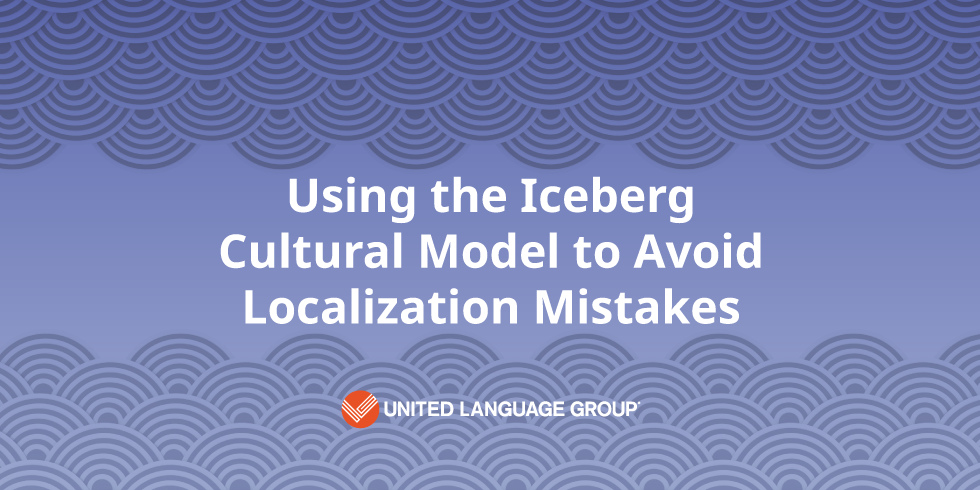Taking a marketing campaign global is a large investment in terms of time, cost, and effort. The last thing anyone wants is for that launch to flop because of a cultural oversight, but it happens more often than you would think. Success in the global business landscape requires more than a surface-level familiarity with your target market’s culture. In this post, we’ll explore:
- Why it’s so important to start the localization process with a deep understanding of the specific culture you are localizing for,
- How understanding and respecting cultural differences can become a strategic advantage to propel your brand to international success, and
- How to approach gaining a deeper understanding of your target culture.
But first, let’s get some clarity on what we mean when we say culture, and why it’s so important.
What is Culture?
Culture includes all the shared values, practices, and beliefs that shape the behaviors and perceptions of people in a society. It’s all the threads that weave together to form the invisible fabric of community identity, comprised of everything from language and art to social norms and business etiquette. Understanding culture means looking beyond the obvious (what they do) and appreciating the unseen codes and conventions (how they feel) that guide daily interactions and decisions.
Why Does Culture Matter in Localization?
Without a detailed understanding of a society's cultural drivers, even the most polished marketing campaigns can misfire.
Case in point: when Walmart attempted to enter the German market, the chain’s corporate culture and the in-store experience it provided failed to align with German cultural expectations. For example, they required their employees to smile and make small talk with customers while bagging groceries, but in Germany, “People found these things strange; Germans just don’t behave that way,” a German union representative said in the New York Times.
In another example, Starbucks has yet to capture the hearts of Vietnamese coffee consumers, in part because the chain’s offerings are not aligned with the country’s vibrant pre-existing coffee culture.
In the 1950s, Pepsi decided to change the color of their PepsiCola vending machines in Southeast Asia from a dark blue to an icy, light blue. Unfortunately for Pepsi, light blue was associated with death and sorrow in that area of Asia. As a result, Pepsi’s market share in that region fell significantly.
These examples highlight the importance of cultural relevance—the art of aligning your brand's message with the cultural context of your target market. Achieving this alignment means tapping into the cultural drivers of engagement (CDE), the factors within a culture that affect how a customer engages with a company. Whether it's values, humor, symbols, or social norms, understanding these drivers is crucial for resonating with local audiences.
Using the Iceberg Model for Culture
The Iceberg Model of culture is a clear framework to help organizations avoid missteps like those described above. The Iceberg Model uses the characteristics of an actual iceberg as a metaphor—we can only observe 10% of the actual iceberg, and the rest is hidden beneath the surface of the water. In the same way, when observing a culture, 90% of that culture is hidden from casual observation, and we can only see the basic characteristics of the culture.
The Iceberg Model breaks down all aspects of a culture into three categories – surface culture, unspoken rules, and unconscious rules – each one diving deeper into the cultural “iceberg.” A combination of these three types of characteristics make up every culture around the world.
Level One: Surface Culture
The first category is surface culture, which includes all the easily observable characteristics. This is culture as a tourist would experience it, and it includes elements like language, currency, art, food, music, holidays, fashion, and religion.
In Vietnam, Starbucks carefully designed its stores with Vietnamese architectural features. However, this is surface-level culture, and it was not enough to endear them to Vietnamese coffee drinkers.
Level Two: Unspoken Rules
The second level in the Iceberg Model is hidden underneath these surface characteristics; they’re called unspoken rules. Unspoken rules take more time for an outsider to understand. These characteristics include business etiquette, social etiquette, conceptions of modesty, and the symbolism of objects, colors, and individuals.
These unspoken rules are part of the CDE, and brands violate them at their peril. Pepsi’s vending machine mishap was caused by not understanding unspoken rules about color symbolism in Southeast Asia.
Level 3: Unconscious Rules
Unconscious rules are the deepest level of a culture, which makes them the most difficult characteristics to learn and navigate. Because they’re rooted so deeply within a culture, it’s difficult even for those within a given culture to articulate them, or even to notice them. And yet, unconscious rules can still be the most critical for outsiders to know and understand.
Unconscious rules include things such as verbal and non-verbal communication, sense of time, whether communication is high-context or low-context, concepts about death, concerns about the present versus the future, how people experience physical space, emotional responses, and concepts of right or wrong, and good or bad.
For example, Japan is a high-context culture that emphasizes the importance of social harmony. This is demonstrated by the Japanese concept of "reading the air" (空気を読む, kūki o yomu), where individuals are expected to understand the context of a situation and act appropriately without direct instruction. Brands, too, need to “read the air” to succeed in these cultures.
Like unspoken rules, unconscious rules are also part of the CDE, and determine how individuals from your target culture will engage with your brand.
(For an amazing book that digs deeper into these concepts, check out The Culture Map by Erin Meyer).
How to Apply Cultural Knowledge in Your Localization Program
Now you have a better understanding of what culture is and what cultural knowledge you need to be successful, including the cultural drivers of engagement (CDE). The next step is to apply that knowledge and use the CDE to create experiences that resonate across cultures. Here are some examples of how to accomplish this:
- Adapt content for local audiences: Localize your content by adapting for cultural preferences, from imagery to idioms. Language translation is only the first step; effective adaptation also includes contextualizing and potentially recrafting your message to fit cultural norms.
- Fine-tune brand messaging: Adapt slogans and messages to make sure they carry the intended impact in each culture. Marketing history is littered with stories of translated taglines gone wrong, like when KFC accidentally urged Chinese consumers to “eat their fingers off” thanks to a mistranslation of their iconic slogan “It’s finger-licking good!” Getting it right might mean creatively reimagining your brand’s voice to maintain its essence across diverse markets.
- Localize your website: Tailor your digital presence to reflect local customs, preferences, and celebrations. This shows respect for and understanding of the local culture, enhancing the customer’s online experience with your brand.
- Cultivate culturally competent interactions: Make sure your customer service isn't just multilingual but also culturally aware. Representatives should be able to connect with customers not only through language but through cultural understanding as well.
- Make it easy for people to reach interpreters in their language. This could be through a smart, in-language IVR or a program like ULG’s Direct Connect to connect callers with interpreters right away, so they can easily reach you in their preferred language right from the start.
By applying these principles, brands can navigate cultural nuances successfully, fostering deeper engagement with their global audience.
How Brands Can Change Culture
In an interesting flip, some big brands are strong enough to change a target culture.
Adapting to the local culture is usually the safest route, but in some cases, brands can be catalysts for change. By introducing innovative products, marketing campaigns, and consumer experiences, they can alter perceptions and establish new trends in their target markets.
For example, Starbucks has actually changed coffee culture in some countries, like the Czech Republic. When Starbucks first opened in Prague in 2008, people in Czechia didn’t go out for coffee much. Coffee was usually prepared at home using traditional Turkish preparation methods. Now, cozy coffee shops with flavored cappuccinos are common and people enjoy going to coffee shops, getting a specialty drink, and socializing or working in that setting.
With a deep understanding of cultural drivers and a commitment to innovation, it's possible to not only navigate but also mold the cultural landscape. However, we recommend proceeding with caution here, and expert advice.
How ULG Can Help
We're your cultural navigators, ready to help your brand connect deeply and authentically with audiences around the world. Our team brings a rich understanding of the CDE and the know-how to make your brand’s voice heard and felt across different markets. Our experts can help align your messaging and content to the cultural contexts of your target audiences, turning cultural challenges into opportunities for connection and growth.
Ready to gain a deeper understanding of the cultures and people you’re speaking to?
Connect with United Language Group to help craft culturally relevant, multilingual communications to connect with the diverse groups of consumers you serve. Contact us for a consultation today!



